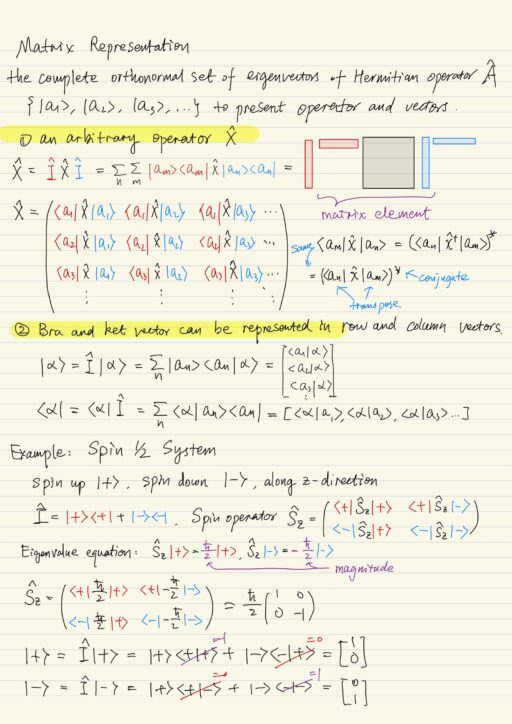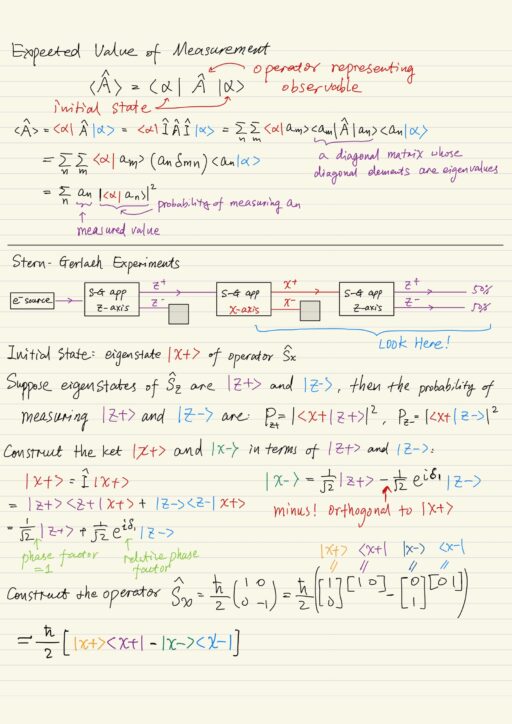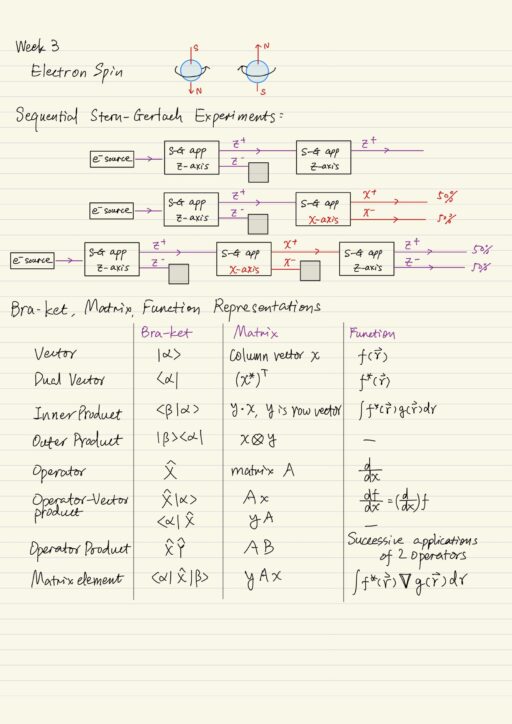Electron Spin
Electron has intrinsic angular momentum called spin that is not associated with its orbital motion. And just like orbital angular momentum, spin angular momentum produces magnetic moment. Therefore electrons interact with magnetic field through both orbital and spin angular momentum.
The electron is not actually spinning, electron produces angular momentum as if it were spinning.
| Rotation about z axis | Spin | Magnetic moment | S pole | N pole |
| Counterclockwise | Upward | Downward | Up | Down |
| Clockwise | Downward | Upward | Down | Up |
Stern-Gerlach experiment shows that the intrinsic angular momentum state of electron is quantized into either up or down.
Measurement
The measurable quantity in quantum mechanics is represented by an operator. The allowed quantum states are represented by the eigenstates of that operator. We collapse the state of the system into one of the allowed states when we make a measurement in quantum mechanics. In the case of Stern-Gerlach experiment, these allowed states are either spin up or spin down state.
Suppose we measured energy of a quantum system and obtained a certain value En. The operator for energy id the Hamiltonian H. The quantum mechanical explanation of what actually happened is the quantum system has “collapsed” into the eigenstate of H corresponding to the eigenvalue En. The probability of measuring En depends on the initial state. Other values are possible, and we can only predict the probability of measuring certain values. We cannot deterministically predict exactly what will happen when we do these measurements.
Dirac’s Bra-ket Notation
In Dirac’s bra-ket notation, a state vector specifying a quantum state is denoted by a “ket”:
|α⟩, where α is the quantum stateA ket is postulated to contain all information that we need to know about the system. Ket is a vector in a vector space in mathematical terms and the dimensionality of the vector is specified according to the nature of the physical problem that we’re dealing with.
For example in Stern-Gerlach experiment, the ket vector is 2-dimensional for electron spin. Another example is infinite potential well problem, where there are infinitely many eigenstates, the ket space is infinite dimensional and ket vector is also infinite dimensional.
Kets can be added together or multiplied by a constant:
|α⟩ + |β⟩ = |γ⟩
c |α⟩ = |α⟩ cAn important physics postulate is that c |α⟩ and |α⟩ represent the same state as long as c ≠ 0.. Only the direction of the vector contains physically meaningful information, the amplitude or the magnitude of the vector does not. The multiplicative constant can always be determined at the very end by imposing the normalization condition.
Observable
An observable (momentum, spin, etc) can be represented by an operator, which acts on a ket, and turns the ket into another ket:
A^ |α⟩ = |β⟩In general |β⟩ ≠ c |α⟩, so performing a measurement on a quantum system turns the quantum state into another state. It alters the quantum state.
There exists a special set of kets called eigenkets for a given operator which satisfy A^ |α'⟩ = α' |α'⟩, A^ |α''⟩ = α'' |α''⟩, etc. The multiplicative constant on the right-hand side are called the eigenvalues. When a quantum system was originally in an eigenstate, making a measurement does not change the state.
Bra Vectors
A bra vectors ⟨α| is a dual to the ket vector |α⟩, very much like the row vectors are dual to column vectors. There is a one-to-one correspondence between a ket space and a bra space. Bra vectors and ket vectors are related to each other by complex conjugates and transpose.
c |α⟩ = c* ⟨α|Inner Product
Inner products are defined as ⟨β|α⟩ which results in a complex number. There are 2 important properties:
⟨β|α⟩ = ⟨α|β⟩*
⟨α|α⟩ ≥ 0Two kets are orthogonal if ⟨β|α⟩ = 0, The norm of a ket is defined as √⟨α|α⟩. A ket whose norm is zero is called a null ket. A ket which is not a null ket can be normalized as:
|α~⟩ = |α⟩ / √⟨α|α⟩Outer Product
Outer products are defined as |β⟩⟨α|, which results in an operator.
Generality
The bra-ket notation is abstract and general, it could be like this. It can denote any quantum state whether it can be expressed as spatial functions or not. For mathematical manipulation or calculations, bras and kets are commonly represented by functions or matrices.
| whatever you choose to specify a quantum state ⟩Operators
An operator is something in linear algebra that acts on a vector and convert it into another vector. In bra-ket notation, we can write X^ |α⟩ = |β⟩, an operator acts on a ket from the left. In quantum mechanics, observables like momentum and spin are represented by operators. There are also operators that are not related to observables, such as rotation and translation.
Two operators are said to be equal X^ = Y^, if X^ |α⟩ = Y^ | for any arbitrary ket α⟩|α⟩ in the ket space under consideration. Operators can be added and addition is commutative and associative.
X^ + Y^ = Y^ + X^
(X^ + Y^) + Z^ = X^ + (Y^ + Z^)Operators can be multiplied. Multiplication is not commutative but associative.
X^ Y^ ≠ Y^ X^
(X^ Y^) Z^ = X^ (Y^ Z^)Associativity applies to multiplication with vectors too:
(X^ Y^) |α⟩ = X^ (Y^ |α⟩) = X^ Y^ |α⟩
(⟨α| X^) Y^ = ⟨α| (X^ Y^) = ⟨α| X^ Y^An operator can act on a bra vector from the right. ⟨α| X^ = ⟨β|. In general X^ |α⟩ and ⟨α| X^ are not dual to each other. Instead we define Hermitian adjoint operator X^† of X^ such that ⟨α| X^† is dual to X^ |α⟩. Note the property:
(X^ Y^)† = Y^† X^†An operator is Hermitian if X^† = X^. Hermitian operators form an important class of operators in quantum mechanics, because physically observable variables are represented by Hermitian operators. It has three important properties:
- Eigenvalues are real
- Complex conjugate of eigenvalue equals the eigenvalue itself:
a* = a.
- Complex conjugate of eigenvalue equals the eigenvalue itself:
- Eigenvectors correspond to different eigenvalues are orthogonal
- If you have multiple vectors that are associated with the same eigenvalue, we call that phenomenon degeneracy. When there is degeneracy, you can always choose mutually orthogonal vectors.
- We can also extend this orthogonality properties to the degenerate case, as well.
- Eigenvectors form a complete set
- A set of vectors
{ |a1⟩, |a2⟩, |a3⟩, ... }is said to be complete, if it is possible to express all vectors in a given vector space by a linear combination of all vectors in the set.
- A set of vectors

Associative Axiom
There are illegal products that are not allowed: |α⟩|α⟩, ⟨α|⟨α|, X^ ⟨α|, |α⟩ X^.
Associativity holds broadly for all legal products. Incidentally ⟨α| X^ |β⟩ = (⟨β| X^† |α⟩)*, if the operator is Hermitian.
Matrix Representation
We will use the complete orthonormal set of eigenvectors { |a1⟩, |a2⟩, |a3⟩, ... } of Hermitian operator as the basis to present the operator and other vectors in matrix form. Hermicity of operator X^ ensures the hermicity of its matrix representation. Taking complex conjugate and transpose keeps the matrix the same.

Spin 1/2 System
In the Stern-Gerlach experiment, we found that the electron spin is quantized into two possible states, spin up |+⟩ or spin down |-⟩ along z-axis. Then the identity operator is:
I^ = |+⟩⟨+| + |-⟩⟨-||+⟩ and |-⟩ are eigenkets of the operator S^z representing spin along z direction:
S^z |+⟩ = (h/2) |+⟩
S^z |-⟩ = -(h/2) |-⟩Measurement (again)
Now, using the linear algebra language, we can say more specifically that when we make a measurement, then the quantum state of the system collapses into one of the eigenstates of the operator representing the physical variable that we’re measuring.
Suppose we want to measure a physical variable represented by an operator A^, whose eigenstates or eigenkets are { |a1⟩, |a2⟩, |a3⟩, ... } .
| Initial quantum state | Upon measurement |
not one of the eigenstates|α⟩ | Collapsing into one of the eigenstates |an⟩with probability |⟨an|α⟩|2 |
one of the eigenstates|ak⟩ | Preserve the state |
We postulate the probability of measuring eigenvalue an corresponding to eigenstate |an⟩ is given by |⟨an|α⟩|2, provided |α⟩ is normalized.
We can not know precisely what value we will be measuring, we can predict an average value we will be getting upon many measurements by calculating the expectation value which is defined as:
⟨A^⟩ = ⟨α| A^ |α⟩Stern-Gerlach Experiments revisited


S^x = (h/2) [ |z+⟩ ⟨z-| + |z-⟩ ⟨z+| ]
S^y = (h/2) [ -i |z+⟩ ⟨z-| + i |z-⟩ ⟨z+| ]
S^z = (h/2) [ |z+⟩ ⟨z+| + |z-⟩ ⟨z-| ]Spin operators do not commute with one another: S^x S^y ≠ S^y S^x. So a commutator bracket is defined:
[A^, B^] = A^B^ - B^A^For spin operators we get this: where εijk equals 1 when i,j,k are cyclic, equals -1 when anti-cyclic and equals 0 otherwise.
[S^i, S^j] = i εijk h S^k, where i,j,k = x,y,zInstead if we define (S^)2 = (S^x)2 + (S^y)2 + (S^z)2, we will get [(S^)2, S^i] = 0.
My Certificate
For more on Stern-Gerlach Experiments & Dirac Bra-ket Notation, please refer to the wonderful course here https://www.coursera.org/learn/foundations-quantum-mechanics
Related Quick Recap
I am Kesler Zhu, thank you for visiting my website. Check out more course reviews at https://KZHU.ai
